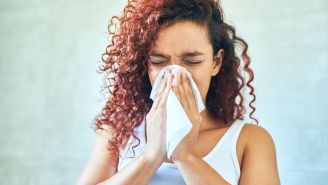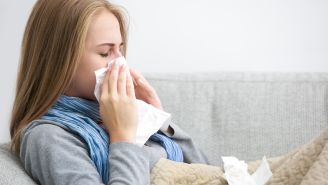Updated on September 11, 2023.
Respiratory infections like flu and colds are more common in the colder fall and winter months. Some people may feel like they’re jumping from one illness to the next, experiencing a variety of symptoms ranging from achiness and fatigue to congestion or an upset stomach.
In most cases, staying home, drinking fluids, and resting does the trick and people often feel better within a week or two. As a result, it may seem like it doesn’t even matter exactly what you have. But there are some key differences between a cold, the flu, stomach flu, and COVID— including how serious these infections can get and how easily they spread.
Understanding the differences between these infections can help you treat yourself most effectively, recover more quickly, and help avoid passing germs to others.
What causes cold, flu—and covid
Although COVID, the common cold and flu are all viral infections that primarily affect the respiratory tract, they’re caused by different viruses. The cold is caused by a variety of viruses that includes rhinovirus, coronavirus, and adenovirus, while the flu is caused by either influenza A or B viruses.
COVID, on the other hand, is a disease that was originally caused by a virus called SARS-CoV-2. While the original COVID strain is no longer in circulation, variants of this virus remain and are responsible for new COVID infections in the U.S. and other parts of the world.
COVID, cold viruses, and flu can spread through the air when people who are sick cough, sneeze or even talk. Airborne droplets that contain the virus can enter your body through your nose or mouth. You can also pick up these bugs by touching contaminated surfaces and then touching your eyes, nose, or mouth.
Keep in mind, all these infections are highly contagious, but COVID spreads even more easily than the flu.
Some symptoms overlap, some are distinct
It can be tricky to tease out a diagnosis of COVID, a cold or the flu based on your own symptoms, since there is considerable overlap between them.
COVID, colds or the flu can all cause sneezing, congestion or runny nose, and sore throat. People with one of these infections can also develop a cough, though chest discomfort that accompanies a cold is typically less severe than that associated with the flu or more severe COVID. You may also feel fatigue or weakness with any of these illnesses, but the severity also tends to be greater with the flu and more serious COVID infections.
Meanwhile, some of the flu’s hallmark symptoms—body aches, fever, chills, and headache—are also common among those with COVID. By comparison, fever is rare in adults with a cold.
Another clue you may have a flu rather than a cold is if your symptoms appeared suddenly. Cold symptoms tend to develop slowly, while flu tends to hit you hard, quickly, and results in a more severe illness.
For those with COVID, symptoms can range from mild to severe and may appear anywhere from two to 14 days after exposure to the virus. Some additional signs of COVID infection may include nausea or vomiting, diarrhea, or new loss of taste or smell.
Although there are a variety of over-the-counter remedies available for cold symptoms, there are no treatments that attack the cold virus directly as anti-viral meds do for COVID or the flu.
Similarly, while there are vaccines to help protect against COVID and the flu (virtually everyone should get a seasonal flu shot by the end of October before flu season begins), there is no vaccine to reduce your chances of picking up a cold.
Cold, flu, COVID… what difference does it make?
In the best-case scenario, colds, mild to moderate COVID cases and the flu typically resolve on their own within about 10 to 14 days. But the stakes are much higher for severe cases of COVID or the flu, which can result in serious and potentially fatal complications.
If you’re otherwise healthy, it’s less likely that you’ll experience adverse effects from COVID or the flu. But certain populations are at higher risk, including children younger than 5 years old, adults ages 65 and older, pregnant people, those with extreme obesity, nursing home residents and people with weakened immune systems or certain medical conditions, such as chronic lung or heart disease, or diabetes.
Flu and COVID testing and treatment
People who have COVID symptoms or who have been exposed to someone who is infected should be tested for the virus. Testing helps health officials track disease activity across the country. Some people diagnosed with COVID may also be candidates for antiviral therapies, which could help them recover more quickly and avoid more serious complications.
Most people who are not at risk for serious flu-related complications don’t need to be tested for the seasonal virus, since their course of treatment—rest, treating fever with acetaminophen, drinking clear fluids—won’t change. But for those with severe infections and people at high risk for flu may be candidates for more aggressive treatment with a prescription antiviral drug like oseltamivir.
Antiviral treatment, however, tends to have the greatest benefit when started within 48 hours of developing symptoms and should begin right away. As a result, healthcare providers may not wait for test results to start treatment in high-risk individuals or may even prescribe treatment despite a negative result if the situation calls for it.
In certain cases, the flu or COVID may require emergency medical help. Call your doctor immediately or head to the ER if you experience:
- Flu symptoms that seem to improve but then return with fever and a worsening cough
- Persistent, severe fever higher than 104° Fahrenheit
- Difficulty breathing or shortness of breath
- Pain or pressure in the chest or abdomen
- Dizziness, confusion, or seizures
- Severe vomiting or diarrhea (this is rare in adults)
- Being unable to urinate
- Severe muscle pain
- Worsening of chronic medical conditions
Likewise, children or infants showing any of the following signs should receive immediate medical attention:
- Fast breathing or difficulty breathing
- Blue skin color
- Not eating or drinking enough fluids
- Not waking up from naps or not interacting
- Excessive irritability
- Persistent fever higher than 102° Fahrenheit, or higher than 100.4° for babies younger than 3 months
- Seizures
- Stiff neck
- Persistent pain, such as an earache, sore throat, or stomachache
- Fewer wet diapers than normal
- Crying without tears
- Severe vomiting or diarrhea (this is rare in adults)
Many of the symptoms associated with more severe COVID or the flu—including fever and sweating, as well as less common symptoms such as loss of appetite, vomiting and diarrhea—can contribute to dehydrating the body, which is why the steady intake of fluids is important. Staying hydrated aids your immune system’s fight against infection, while dehydration can contribute to some more severe complications.
Dehydration is more than just feeling thirsty. It can lead to a dangerous electrolyte imbalance, a risky drop in blood pressure, and kidney failure. Severe dehydration can also lead to swelling of the brain.
Can you get the flu in your stomach?
Despite the name, the stomach flu is not an influenza virus that migrates into the gastrointestinal (GI) tract. Stomach flu is a misnomer and typically refers to viral gastroenteritis, an inflammation of the intestinal tract most commonly caused by norovirus, but sometimes also by rotavirus, astrovirus or enteric adenovirus. (Other forms of gastroenteritis may be caused by bacteria or parasites.)
Although viral gastroenteritis may sometimes cause generalized symptoms like those seen with the flu—headache, chills, aches, pains, and fatigue—it usually doesn’t cause fever, and if it does, it tends to be low-grade. Instead, symptoms tend to congregate in the gastrointestinal tract and may include diarrhea, nausea, stomach pain, and vomiting. Adding to the confusion, influenza may occasionally also cause diarrhea or vomiting in adults (though these tend to crop up more commonly in children).
Stomach flu typically spreads through contaminated food or water, and you can also pick it up through contact with the fluids of with an infected person or by touching contaminated surfaces. Less commonly, the bug can be transmitted via droplets projected into the air via vomit, as opposed to the sneeze- or cough-borne particles that transmit the flu.
Although there are no anti-viral treatments to cure stomach flu, the good news is that viral gastroenteritis typically clears up within a day or two.
But as with severe COVID or the flu, dehydration is a concern, particularly since people with stomach flu lose fluids through vomiting and diarrhea. This can quickly lead to dehydration, particularly among children. “
It’s therefore crucial to stay hydrated. If vomiting is an issue, it may help to drink small amounts of clear liquids (2 to 4 ounces) at a time. Water is the go-to, but you can also try rehydration drinks like Pedialyte or sports drinks like Gatorade to help replenish electrolytes.
Rest and fluids are typically all you need to recover, but if diarrhea lasts for more than a few days or becomes bloody, or if you experience any of the following signs of extreme dehydration, contact your healthcare provider:
- Confusion or dizziness
- Dry or sticky mouth and throat
- Decrease in urination or concentrated urine that looks dark yellow
- Unusual sleepiness, fussiness or lack of tears when crying (typically seen in children)
- Severe dehydration may require hospitalization and IV treatment.
- Frequent vomiting
- Severe abdominal or rectal pain
- Stool (poop) that contains blood or pus
People who are not able to tolerate food, have a persistent high fever (higher than 104° Fahrenheit for adults, 102° Fahrenheit for children, or 100.4° Fahrenheit for babies younger than 3 months), or who are too sick to care for themselves, should seek medical attention to help ensure they are properly re-hydrated.
Steering clear of COVID, colds, the flu, and stomach flu
Despite the differences in treatment approaches to colds, the flu, COVID, and stomach flu, there are simple preventive measure that help people avoid all of them:
- Wash your hands often and thoroughly with soap and water for at least 20 seconds. If you don’t have access to soap and water, an alcohol-based hand sanitizer is a good alternative. Before applying the liquid or gel, remove as much dirt or debris from your hands as possible. Read the product label for instructions and apply as much as directed to ensure its effectiveness. Then, rub the sanitizer over all surfaces of your hands until they are dry.
- Be sure that your hands are clean before eating or touching your eyes, mouth, or nose, after using the bathroom and while working in the kitchen.
- Cover your cough or sneeze with an unused tissue, then throw the tissue in the trash. If you don’t have a tissue, use your upper sleeve or elbow—not your hands.
- Clean and disinfect commonly used objects and surfaces you come touch throughout your day, such as computer keyboards, cell phones, doorknobs, faucets, and bathroom fixtures with household cleaning sprays or wipes.
- Avoid sharing personal items, such as pens, dishes, utensils, water bottles and drinking glasses.
- Do what you can to stay healthy and keep your immune system strong, such as getting quality sleep, following a healthy diet, and exercising regularly.
And the best way to protect against severe COVID and the flu is to be fully vaccinated.







